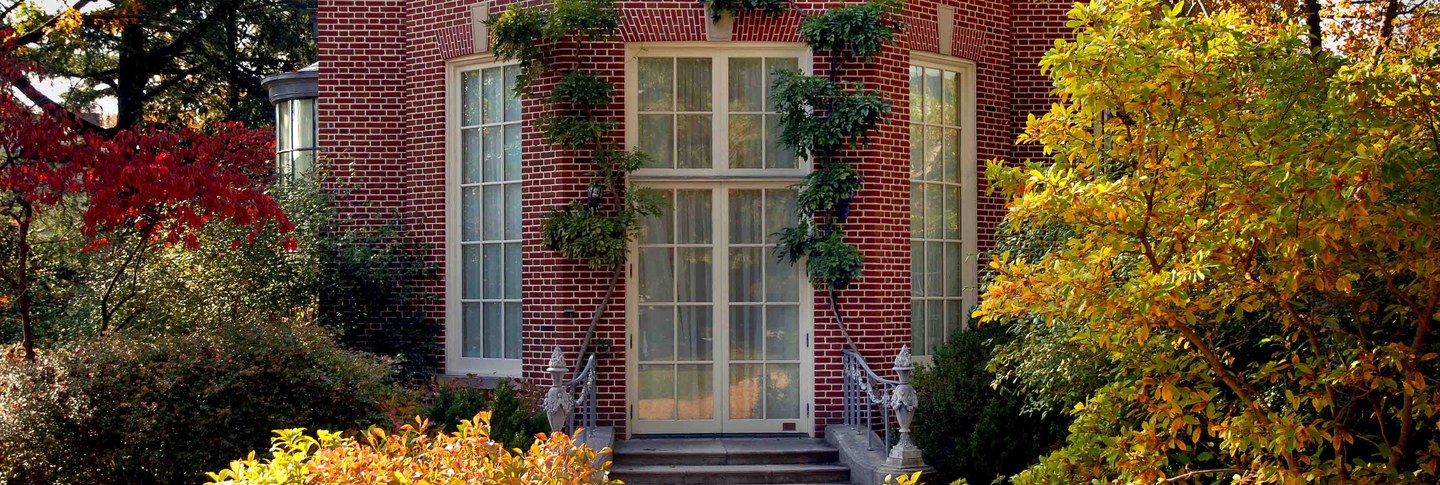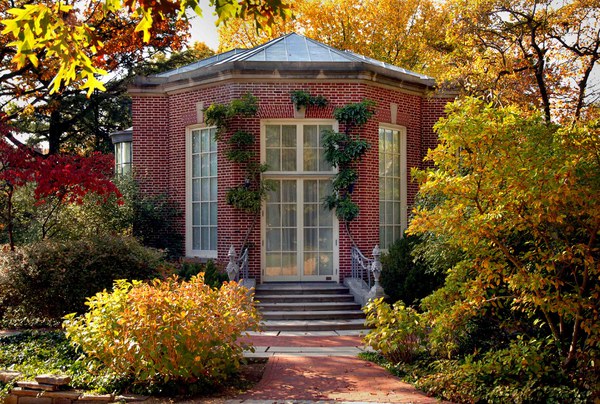Between 1947, when Mildred Bliss seriously began to acquire rare garden library books, and the late 1950s, the Garden Library Rare Book Collection grew rapidly. Within a decade, it contained publications dating to over four centuries and could boast, in the words of director John S. Thacher, “virtually every major work relating to garden design which was published in Europe and America.” However, by the late 1950s, the collection had outgrown its housing in the Founders Room. Space had become so limited that some acquisition opportunities had to be turned down for lack of shelving. Among the notable books under consideration that were declined was the Comte de Buffon’s seminal thirty-five volume Histoire naturelle.
In order to make further growth possible, in 1959 the Blisses offered the funds for an additional wing to house the Garden Library Rare Book Collection. Designed by Frederic Rhinelander King in 1960, the Garden Library Rare Book Room was conceived in a French neoclassical style reminiscent of an eighteenth-century European library. Books were kept in elegant mesh-fronted cases in the company of paintings and antique furniture formerly owned by the Blisses.
To insure the maintenance of this collection as well as the gardens themselves, and to assure that both would help to advance scholarship in garden design, the Blisses already, in 1951, had established the Dumbarton Oaks Garden Endowment Fund Number I in the amount of $250,000,
. . . for the maintenance, operation and development of the Gardens at Dumbarton Oaks; for the establishment of Visiting or Exchange Fellowships to or from this or other countries for the individual study of Garden Design and Ornament; for the publication of monographs or books on such subjects as garden design and ornament—and incidental decorative horticulture; for the maintenance and enlargement of the Garden Research Library already established at Dumbarton Oaks; for the support of the Garden Information Center; and for other related educational purposes.
In making this gift, however, the Blisses were quick to point out to the President and Fellows of Harvard College both its restrictions and its overreaching purpose:
This fund is not be limited to the actual maintenance, operation and development of the Gardens, which are now supported from the income of the original Dumbarton Oaks Endowment Fund established by one of our letters to you dated July 2, 1940. It is our hope and expectation that the Dumbarton Oaks Gardens may in time attain as high a standing in the study of, and for its publications on, Garden Design and Ornament as the Dumbarton Oaks Research Library and Collection has already attained for its scholarly work and research. Thus will the unusual potentialities of its Gardens be fully realized.
In 1957, Ralph Griswold became the first fellow appointed to the program that the Blisses had created, and he was followed in the early 1960s by further appointments, including those of David Chase, Bodfan Gruffydd, and Georgina Masson.
When Mildred Bliss died in 1969, the Garden Library Rare Book Collection consisted of some twenty-four hundred rare books, five thousand reference works, and a significant number of prints and drawings. The nascent program had also seen the appointment of nine fellows. As part of her residuary bequest to Harvard University on behalf of Dumbarton Oaks, Mildred Bliss increased the standing of the garden program by establishing the Dumbarton Oaks Garden Endowment Fund Number II, now in the amount of six million dollars,
For the maintenance, operation and development of the gardens at Dumbarton Oaks including the establishment and maintenance of visiting or exchange fellowships for the individual study of garden design, and ornament and special planting; the publication of monographs or books on such subjects as plant material, design ornament and subjects germane to city and country gardens.

With this new and sizable endowment, in the early 1970s Dumbarton Oaks could formally inaugurate a Garden and Landscape Architecture Studies program, created on the model of the existing Byzantine Studies program. To facilitate this, a significant reorganization of the Garden Advisory Committee took place and a director of studies was appointed. This director was to be responsible, among other duties, for the expansion of the garden library rare book collection in order to further develop the collection for research purposes.
In 1972, Elisabeth Blair MacDougall was appointed the first director of studies in Garden and Landscape Architecture. Both she and her immediate successor, John Dixon Hunt, who served as Director from MacDougall’s retirement, in 1988, until 1991, focused largely on acquiring rare British, Italian, and French books on garden design and garden ornament. In 1991, Joachim Wolschke-Bulmahn succeeded Hunt as director of studies. A fellow in the Garden and Landscape Architecture Studies program the previous year, Wolschke-Bulmahn was familiar with both the reference and rare book collections and recognized that they had noticeable strengths and weaknesses. Working with librarian Linda Lott, he sought to augment the library’s holdings in areas where the collection was lacking, particularly German garden literature and American garden books of the eighteenth and nineteenth centuries.
Today, the Garden Library Rare Book Collection contains over seven thousand works, and the continually expanding reference collection boasts over twenty-one thousand items. Begun as Mildred Bliss’s desire to collect and protect rare books, the collection has evolved into an in-depth collection suitable for scholarly research and publication, just as the Blisses had envisioned it.



